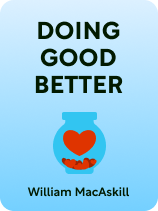

This article is an excerpt from the Shortform book guide to "Doing Good Better" by William MacAskill. Shortform has the world's best summaries and analyses of books you should be reading.
Like this article? Sign up for a free trial here.
Are you passionate about making a real difference in the world? What criteria should you use to choose which causes to support for maximum impact?
William MacAskill’s book Doing Good Better offers insights on selecting effective altruism causes. He proposes evaluating problems based on their magnitude, feasibility, and how underappreciated they are. This approach helps you identify where your efforts can have the greatest positive impact.
Keep reading to discover how you can make more informed decisions about which global issues to tackle.
Determine Which Problems to Address
MacAskill writes that effective altruism can also inform your decision of which problems to address—whether directly, via working for an organization focused on a specific cause, or indirectly, via donating money to an organization that focuses on a specific cause. He contends that you should assess effective altruism causes via three dimensions: What is the magnitude of the problem? How feasible is solving the problem? And how underappreciated is the problem?
Dimension #1: Magnitude
To start, MacAskill explains that we should focus on problems of greater magnitude, all else being equal. In other words, we should tackle issues that have the largest impact on well-being worldwide. For example, researchers estimate that cardiovascular diseases cost 393 million QALYs annually, whereas mental health disorders cost 125 million QALYS annually. Consequently, MacAskill would suggest that we should prioritize addressing cardiovascular diseases instead of mental health disorders, holding all other factors equal.
(Shortform note: Although MacAskill suggests that we focus on issues with the largest worldwide impact, effective altruists have more recently moved toward focusing on issues with the largest possible impact. That is, many effective altruists are especially concerned with existential risks, like climate change, that could wipe out humankind altogether, even though the likelihood of these risks is low. These effective altruists reason that, although problems that currently plague the world might cost millions of lives annually, existential risks could cost billions of lives if they come to fruition. Thus, even though their risk of occurring is low, it still makes sense to tackle these existential threats first.)
Dimension #2: Feasibility
Additionally, MacAskill clarifies that it’s better to focus on problems that we can feasibly solve, rather than those that are less solvable. For example, if it turned out that cardiovascular diseases were significantly more difficult to research, whereas mental health disorders could be treated easily, we should focus on treating mental health disorders—even though it’s a smaller magnitude problem.
(Shortform note: Other effective altruists clarify that feasibility can be measured more formally by asking the following question: If we doubled the resources allocated to a given problem, what percentage of the problem would we solve? For instance, you might think that if we doubled the total resources allocated toward cancer research, we’d be (say) 5% of the way toward curing cancer, making cancer a relatively less feasible problem. By contrast, if doubling the resources used toward food insecurity could put us 25% of the way toward solving that issue, then it would be significantly more feasible to solve.)
Dimension #3: Visibility
Finally, MacAskill argues that you should focus especially on overlooked causes rather than well-known causes. After all, well-known causes (such as climate change) receive more attention, meaning that your donation or labor won’t make a huge difference—even if you don’t donate, the charity will have sufficient funding, and even if you aren’t a climate change researcher, there will likely be sufficient researchers. By contrast, less prominent causes (such as anti-malaria initiatives) pass the counterfactual test, because they will be materially less effective without your donation or direct labor.
(Shortform note: According to experts, affluent Americans in 2022 were most likely to donate to religious causes, educational causes, and causes relating to health care. Thus, it stands to reason that further donations to those causes are likely less effective, since none of them are overlooked.)
Exercise: Consider Which Causes to Address
MacAskill suggests that, to decide which causes to address, we should assess them along three dimensions: magnitude, feasibility, and visibility. Evaluate real-world problems along these lines and decide which are most worthy of your attention.
- Write down three problems that you’ve considered addressing via donating. Why did these causes attract your attention?
- How would you rank these problems in terms of magnitude? Explain your reasoning.
- How would you rank these problems in terms of feasibility to solve? Explain your reasoning.
- How would you rank these problems in terms of visibility to the general public? Explain your reasoning.
- In light of your previous answers, which one of these problems do you think most deserves your attention? To what extent do you agree with this answer?

———End of Preview———
Like what you just read? Read the rest of the world's best book summary and analysis of William MacAskill's "Doing Good Better" at Shortform.
Here's what you'll find in our full Doing Good Better summary:
- How you can save hundreds of lives by being a good person
- The principles behind the effective altruism movement
- How to determine which charities are worth funding






